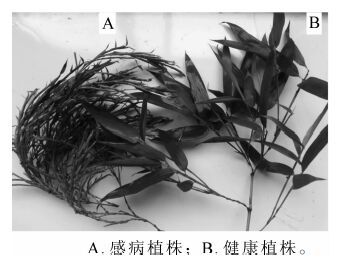-
竹子是多年生的禾本科Gramineae植物。中国约有竹子39属500余种。红哺鸡竹 Phyllostachys iridescens 广泛分布在浙江、江苏、湖北等省,是非常重要的经济和观赏竹。竹子丛枝病(witches’-broom of bamboo)又名扫帚病,鸟巢病,能导致竹子生长衰退,严重影响竹子质量以及出笋率,降低其观赏性,甚至竹子大面积枯死。虽然国内已有一些有关竹子病原菌的研究报道[1-2],但有关竹子丛枝病病原的研究报道相对较少。竹子丛枝病病原复杂,涉及多个病原物如竹针孢座囊菌 Aciculosporium take,竹暗球腔菌Phaeosphaeria bambusae,异香柱菌属Heteroepichloe以及植原体(phytoplasma)等,也有多种病原物混合侵染的报道[3]。竹香柱型丛枝病在中国报道的较少,其病原菌包括箣竹香柱菌Epichloë bambusae和箬竹香柱菌Epichloë sasae等2种。朱熙樵[4]曾在浙江省境内的短穗竹Brachystachyum densiflorum,淡竹Phyllostachys glauce,白哺鸡竹Phyllostachys dulcis及毛竹Phyllostachys edulis上收集到箣竹香柱菌的标本;王华清等[5]也从毛竹上采集到箣竹香柱菌的样品。2002年,日本学者TANAKA等[6]根据形态学结合分子检测的结果,将这2种菌更名为箣竹异香柱菌Heteroepichloë bambusae 和箬竹异香柱菌H. sasae。目前,国内明确的报道是H. sasae能引起箬竹丛枝病[1, 7-8]及短穗竹丛枝病[9]。对于植原体与真菌复合侵染引起丛枝病的情况,有研究发现,水竹Phyllostachys heteroclada丛枝病病枝的电镜观察中同时存在类细菌、植原体和瘤座菌菌丝,并且类细菌的培养液接种健株后能诱发水竹丛枝病[10];朱熙樵等[11]从竹瘤座菌Balansia take引起的竹丛枝病病枝中发现有植原体的存在。本研究应用形态学特征观察结合聚合酶链式反应检测手段,对浙江桐乡市红哺鸡竹丛枝病枝进行了病原物的分离与分子鉴定。
-
红哺鸡竹健株和丛枝病株均于2014年4月采自浙江省桐乡市灵安镇。采集的新鲜样品直接用于试验或保存于-70 ℃备用。
-
观察采集到的新鲜子实体的颜色、大小及质地;作真菌子座横截面的徒手切片,观察真菌的子囊壳、子囊及子囊孢子。
-
取新鲜的子实体,将它切成2~3 mm的小段,用体积分数为75%的乙醇浸泡2~3 s后,再用体积分数为10%的次氯酸钠消毒3~5 min,最后用无菌水漂洗,用灭菌滤纸控干后移植于马铃薯葡萄糖琼脂(PDA)平板上,放入25 ℃的恒温培养箱培养。隔24 h观察并记录真菌的生长状况。
-
①植物总DNA的提取。分别称取0.1 g真菌子座及平板菌丝体,采用Takara各种材料全基因组提取试剂盒(Takara,中国大连)的方法提取总DNA,浓度检测合格后,置于-20 ℃冰箱中备用。②聚合酶链式反应扩增。聚合酶链式反应的引物为真菌内源转录间隔区-核糖体DNA(ITS-rDNA)区段通用引物对ITS1F/ITS4,用Taq酶(Takara,中国大连)进行扩增,具体反应体系参照说明书。聚合酶链式反应条件为94 ℃预变性3 min,35个循环中,94 ℃变性30 s,50 ℃退火45 s,72 ℃延伸1 min,最后72 ℃延伸10 min。产物于4 ℃保存。 ③ 聚合酶链式反应产物的电泳检测及序列测定。聚合酶链式反应产物在10 g·kg-1琼脂糖凝胶,150 V,25 min电泳检测后,委托杭州皓丰生物技术有限公司测序。
-
①植物总DNA的提取。称取0.1 g感病及健康的红哺鸡竹植株的韧皮部组织,采用常规的十六烷基三甲基溴化铵(CTAB)法分别提取总DNA,浓度检测合格后,置于-20 ℃冰箱中备用。②聚合酶链式反应扩增。参照邱并生等[12]的方法,采用巢式聚合酶链式反应的方法扩增植原体。所用引物为植原体通用引物R16mF2/R16mR1及R16F2/R16R2[13],用Taq酶(Takara,中国大连)进行扩增。第1轮以植株的总DNA为模板,R16mF2/R16mR1为引物,聚合酶链式反应条件为94 ℃预变性3 min;35个循环中,94 ℃变性30 s,55 ℃退火45 s,72 ℃延伸1 min;最后72 ℃延伸10 min。第2轮用第1轮扩增产物的50倍稀释液为模板,R16F2/R16R2为引物,退火温度提高到60 ℃,其余条件与第1轮相同。聚合酶链式反应产物的电泳检测及序列测定与1.2.3相同。
-
从美国生物技术信息中心(NCBI)数据库(http://www.ncbi.nlm.nih.gov/)下载与本实验所得序列相关的基因序列,并使用MEGA 6.06[14]数据软件中的neighbor-joining法构建进化树,其中‘bootstrap’设定为1 000次重复,遗传距离使用MEGA 6.06数据软件屮提供的‘Jukes and Cantor ’法进行计算。
-
红哺鸡竹丛枝病多发于老竹林以及缺乏管理且过密的竹林,发病时间多为4月初至7月中旬,发病症状为个别竹枝发病,进而扩展到其他枝条。发病的竹枝呈现扫把状,分枝增多,竹叶明显变小,叶片的颜色也较正常叶片淡(图 1)。
-
子座包裹于竹叶鞘中,为弯曲杆状,中间稍厚,两端稍细,形如香柱,为肉质质地,长度约为3~7 cm,呈灰色或者黑色,中轴有一浅黄色线状条带连接两端(图 2A),切开后内部为绿色。子囊壳大多为长圆形或卵圆形,紧密地着生于子座外侧,颜色为褐色或暗红色,成熟的子囊壳外侧有一孔状开口(图 2B),隐约可见内部长条状子囊(图 2C)。组织分离实验发现,该菌生长极其缓慢,容易被杂菌污染,常规组织分离15 d左右才长出菌丝体,菌丝为纯白色的毛绒状,菌正反面菌丝颜色一致(图 2D)。在对该菌落的逐步观察记录中发现,该菌在组织分离20~30 d生长速度最快,之后生长减缓。
-
以真菌ITS-rDNA区段通用引物ITS1F/ITS4作为引物,从红哺鸡竹子座及平板菌丝体中扩增到了约600 bp的片段(图 3),与预期大小相符;而健康组织及双蒸水的对照中没有出现特异扩增带,说明该病样中确实有真菌存在。
-
利用巢式聚合酶链式反应技术从表现症状的红哺鸡竹的韧皮部组织中没有扩增出片段,而从阳性对照桑萎缩病样品(本实验保存)中扩增到了约1.2 kb的预期大小的片段(图 4)。说明感病红哺鸡竹没有受到植原体的侵染。
-
红哺鸡竹丛枝真菌经测序列得到545 bp的ITS-rDNA序列,将该序列与美国生物技术信息中心中的基因序列进行比对。结果表明:该病原菌与异香柱菌属Heteroepichloë的2个代表种sasae-K,sasae-H(GeneBank登录号:AB065430.1和AB065432.1)的同源性高达97%。从美国生物技术信息中心下载相关的ITS-rDNA序列,并构建系统发育进化树(图 5),结果可见:分离自红哺鸡竹的丛枝真菌与Heteroepichloë sasae-K和Heteroepichloë sasae-H的亲缘关系最近,此节点支持率为100%。
-
本研究通过形态学特征观察和聚合酶链式反应检测从红哺鸡竹丛枝病枝中检测到了1种真菌,并根据ITS-rDNA序列一致性和系统进化树分析结果,明确该真菌为箬竹异香柱菌Heteroepichloë sasae。
目前,已知竹香柱型丛枝病病原有箣竹香柱菌和箬竹香柱菌2种。前者的子座为微黄色,平板培养物分生孢子较短,后者子座为紫色,分生孢子较长,其余构造没有显著差异[6]。采自浙江桐乡红哺鸡竹丛枝病的子座颜色为深紫色,与箬竹香柱菌更为接近;而本试验中,平板纯培养物未能见到分生孢子产生,这也许跟培养时间、温度、营养有关系。本试验采用的是PDA培养基及25 ℃的培养条件,今后可以对这些条件做些调整进行进一步的研究。系统发育学上,ITS-rDNA系统发育树显示,采自红哺鸡竹丛枝病的试验菌株与异香柱菌属Heteroepichloë构成一个分支,且与Heteroepichloë sasae高度聚类,节点支持率达到了100%,说明它们的亲缘关系很近,可以解释为红哺鸡竹丛枝病的试验菌株为H. sasae的1个分离物,由于寄主不同,产生了一些遗传上的差异。
国内异香柱菌引起竹丛枝病的报道较少,对H. sasae 和 H. bambusae这2种病原的描述也比较简单。本研究从红哺鸡竹丛枝病枝上分离到的真菌与程燕林等[9]在短穗竹丛枝病枝上分离鉴定的真菌均为箬竹异香柱菌。这将该真菌的寄主范围又进一步扩大,但该真菌是否为红哺鸡竹丛枝病的病原菌,还需要进一步的致病性实验验证。中国竹丛枝病发生十分普遍,有必要对不同竹种上的香柱菌进行详细的形态学以及分子系统学的研究以确定其分类地位。
Morphological and molecular identification of Heteroepichloë sasae isolated from Phyllostachys iridescens
-
摘要: 竹丛枝病是普遍发生并导致竹林退化的最具破坏性的病害之一。研究该病害的病原对于该病的防治有重大的意义。异香柱菌属Heteroepichloë箬竹异香柱菌Heteroepichloë sasae是引起竹子丛枝病的病原之一。利用形态学结合系统发育分析的方法,对采自浙江桐乡的红哺鸡竹Phyllostachys iridescens丛枝病病原进行了分离鉴定。结果表明:根据该分离物的形态特征、平板纯培养物的培养特征以及基于内源转录间隔区-核糖体DNA(ITS-rDNA)序列的系统发育分析,最终确定为箬竹异香柱菌。该分离物与红哺鸡竹丛枝病的关系还需进一步研究。图5参14Abstract: Witches'-broom, one of the most common diseases of bamboo, induces extremely destructive deterioration of bamboo stands. This study on the pathogens of witches'-broom was conducted to help control the disease. Branches of Phyllostachys iridescens were collected from Tongxiang City in Zhejiang Province, which suffered from witches'-broom, and its pathogen, Heteroepichloë sasae, was studied by morphologic and phylogenetic methods. Results showed that according to morphological, cultural, and phylogenetic characteristics Heteroepichloë sasae was isolated from infected Phyllostachys iridescens branches. However, the relationship between this isolate and witches'-broom disease needs further study.[Ch, 5 fig. 14 ref.]
-
-
[1] 徐梅卿, 戴玉成, 范少辉, 等. 中国竹类病害记述及其病原物分类地位(上)[J]. 林业科学研究, 2006, 19(6):692-699. XU Meiqing, DAI Yucheng, FAN Shaohui, et al. Records of bamboo disease and the taxonomy of their pathogens in China (Ⅰ)[J]. For Res, 2006, 19(6):692-699. [2] 徐梅卿, 戴玉成, 范少辉, 等. 中国竹类病害记述及其病原物分类地位(下)[J]. 林业科学研究, 2007, 20(1):45-52. XU Meiqing, DAI Yucheng, FAN Shaohui, et al. Records of bamboo disease and the taxonomy of their pathogens in China (Ⅱ)[J]. For Res, 2007, 20(1):45-52. [3] 杨永刚, 吴小芹. 竹丛枝病病原研究进展[J]. 浙江农林大学学报, 2011, 28(1):144-148. YANG Yonggang, WU Xiaoqin. Research progress on pathogens of witches' broom of bamboo[J]. J Zhejiang A & F Univ, 2011, 28(1):144-148. [4] 朱熙樵. 竹类几种丛枝病的特征[J]. 森林病虫通讯, 1985,4(2):42-44. ZHU Xiqiao. The characteristics of several kinds of bamboo witches' broom[J]. For Pest Dis, 1985, 4(2):42-44. [5] 王华清, 陈岭伟, 李馥纯, 等. 广东省毛竹丛枝病研究初报[J]. 森林病虫通讯, 1999, 18(3):22-26. WANG Huaqing, CHEN Linwei, LI Fuchun, et al. Moso bamboo witches' broom in Guangdong Province[J]. For Pest Dis, 1999, 18(3):22-26. [6] TANAKA E, TANAKA C, TSUDA M, et al. Heteroepichloë, gen. nov. (Clavicipitaceae; Ascomycotina) on bamboo plants in East Asia[J]. Mycoscience, 2002, 43(2):87-93. [7] 张立钦, 王雪根. 中国竹类真菌资源[J]. 竹子研究汇刊, 1997, 18(3):66-72. ZHANG Liqin, WANG Xuegen. Fungus research of bamboos in China[J]. J Bamboo Res, 1997, 18(3):66-72. [8] 魏景超. 真菌鉴定手册[M]. 上海:上海科学技术出版社, 1979. [9] 程燕林, 侯成林, 高健. 短穗竹上一种异香柱菌的形态学及分子鉴定[J]. 北京林业大学学报, 2009, 31(1):84-90. CHENG Yanlin, HOU Chenglin, GAO Jian. Identification of Heteroepichloe species on Brachystachyum densiflorum by morphology and phylogeny[J]. J Beijing For Univ, 2009, 31(1):84-90. [10] 林雪坚, 吴光金, 徐静辉. 水竹丛枝病的研究(I)症状和病原[J]. 中南林学院学报, 1987, 7(2):132-135. LIN Xuejian, WU Guangjin, XU Jinghui. Study on witches' broom of fishscale bamboo (Ⅰ) symptoms and pathogens[J]. J Cent South For Coll, 1987, 7(2):132-135. [11] 朱熙樵, 黄金生. 关于类菌原体引起丛枝病的探讨[J]. 竹子研究汇刊, 1992, 11(1):4-9. ZHU Xiqiao, HUANG Jinsheng. Approach on witches' broom of bamboos caused by mycoplasma like organism[J]. J Bamboo Res, 1992, 11(1):4-9. [12] 邱并生, 李横虹, 史春霖, 等. 从我国20种感病植物中扩增植原体16S rDNA片段及其RFLP分析[J]. 林业科学, 1998, 34(6):67-74. QIU Bingsheng, LI Henghong, SHI Chunlin, et al. Amplification of phytoplasma 16s rDNA from 20 infected plants in China and their RFLP analysis[J]. Sci Silv Sin, 1998, 34(6):67-74. [13] LEE I M, HAMMOND R W, DAVIS R E, et al. Universal amplification and analysis of pathogen 16S rDNA for classification and identification of Mycoplasmalike organisms[J]. Phytopathology, 1993, 83(8):834-842. [14] TAMURA K, STECHER G, PETERSON D, et al. MEGA6:molecular evolutionary genetics analysis version 6.0[J]. Mol Biol Evol, 2013, 30(12):2725-2729. -

-
链接本文:
https://zlxb.zafu.edu.cn/article/doi/10.11833/j.issn.2095-0756.2016.06.016







 下载:
下载:






